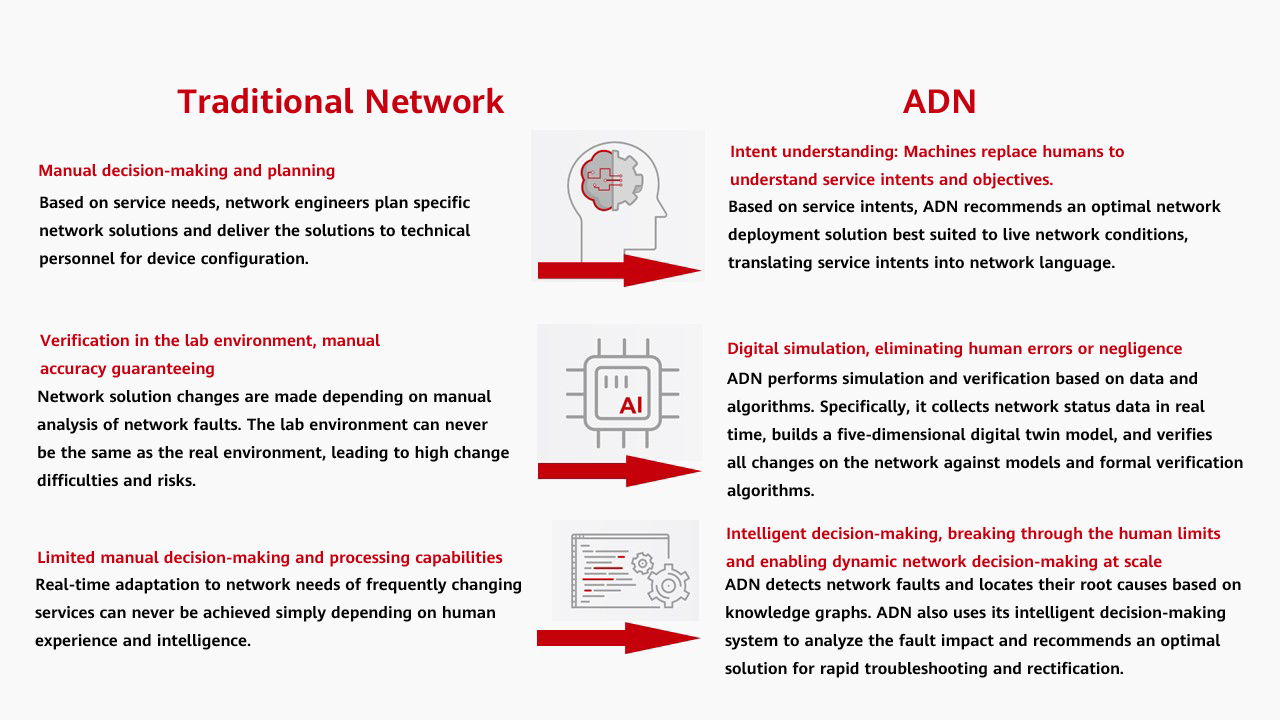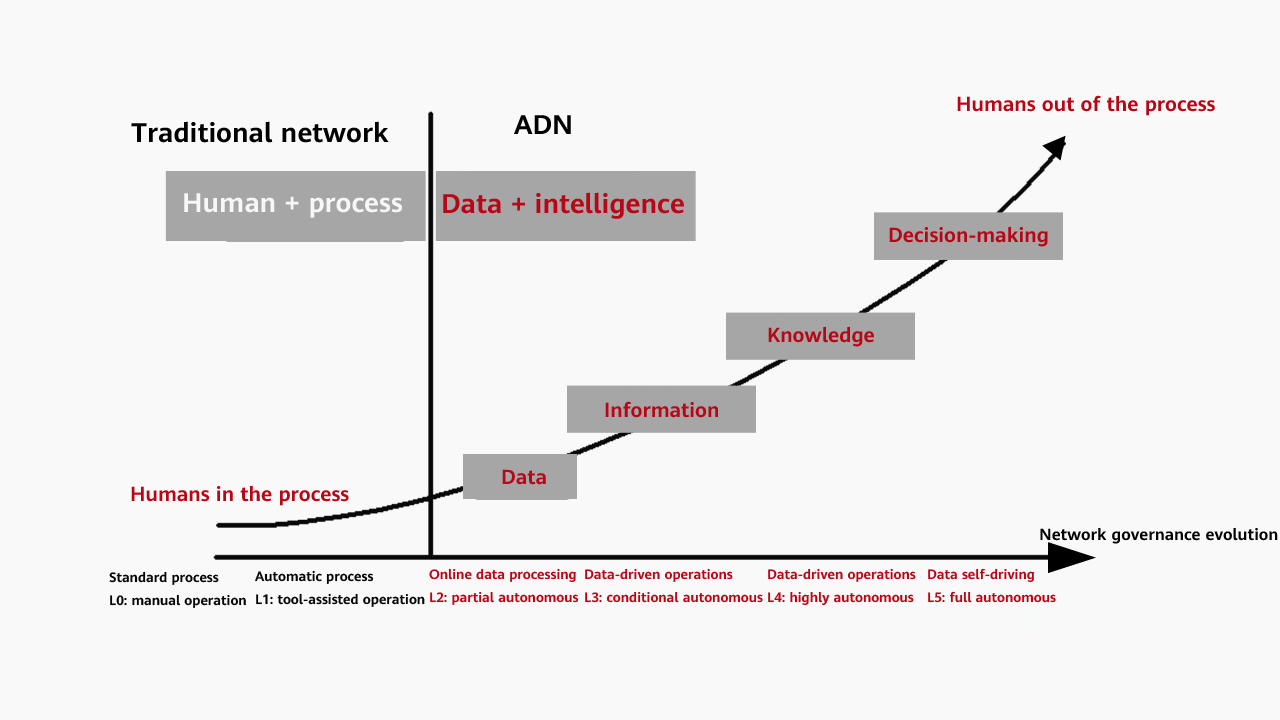What Is ADN?
Since the birth of Ethernet in 1970s, the network has gone through half a century of development. Now, network has become an inseparable part of our life and work. If we compare a network to a road, information is the car, and car driving relies on various types of guidance information alongside the road. Such guidance information needs to be planned and configured manually. As digital transformation speeds up, service volumes increase explosively, raising higher requirements on network experience, which, however, has gone beyond the limits of manual decision-making and processing capabilities. The question is: Can the network work like an autonomous vehicle to free people's hands?
Why Do We Need ADN?
As the intelligent society with all things sensing, connected, and intelligent gathers pace, people's network requirements have evolved from simple multi-device collaboration to ubiquitous access of all people, terminals, applications, and devices. This raises higher requirements on network performance.
- For enterprises: Enterprise digitalization accelerates service iteration. The provisioning and launch of a new service involve a network configuration work order that spans enterprises' campuses, WANs, and data centers and from a cloud to multiple clouds, breaking through the network operations and maintenance (O&M) boundary. As enterprises need to quickly adjust an increasingly growing number of key services, frequent changes challenge manual network O&M. In response, enterprises need to offer intelligent detection and self-optimization capabilities to change from traditional static policies to dynamic policies.
- For individuals: Networks are penetrating into every aspect of our work and life. For example, live streaming, red envelope grabbing during shopping festivals, and online courses have become a part of our daily life. Due to network traffic bursts and uncertainties, flexible scheduling of network resources has become a must. Furthermore, as IoT, smart home, and Internet of Vehicles (IoV) become increasingly popular, network stability and security are facing new challenges.
To tackle such issues and create a superlative network experience with improved service agility and reduced operational expenditure (OPEX), enterprises need an ADN solution that integrates AI and big data technologies to implement network automation and intelligent O&M.

Why do we need ADN?
What Is ADN?
ADN-powered AI drives continuous innovation of the network architecture through knowledge and data, and breaks through the limits of manual processing capabilities. With deep learning, ADN automatically understands service intents and network objectives; with data computing, ADN makes compensation for O&M blind zones beyond the reach of manual experience; with continuous machine learning, ADN breaks through the limits of manual experience-based decision-making. In this way, ADN achieves automation, self-healing, self-optimization, and autonomy, thereby building ubiquitous intelligent networks.
A three-layer AI architecture is used to build intelligent IP networks and accelerate the evolution towards ADN. The three layers from top to bottom are as follows:

What is ADN?
With full-stack AI introduced, the ADN solution automatically converts service needs into network models and languages via deep self-learning. Leveraging AI and knowledge inference, the solution can detect network status in real time, predict network risks, precisely identify root causes of network faults, and automatically rectify faults. The resulting benefits include minimized network faults and maximized network O&M efficiency. The solution stands out with high automation level, self-healing, and self-optimization, and is ideal for achieving network self-evolution and autonomy.
- Automation: Enables automatic deployment of intent services to implement end-to-end (E2E) management and automated deployment of network-wide intents throughout the lifecycle.
- Self-healing: Predicts and prevents faults, and implements self-recovery based on events, achieving automatic O&M on the entire network.
- Self-optimization: Enables self-adaptation and optimization of user experience to implement automatic optimization of the entire network.
How Are the Levels of ADN Classified?
The level setting criteria and evolution roadmap of ADN are specified to guide users on what to do and when to do during their digital transformation. A set of solutions and optimal technical architecture are also provided to guide users to achieve objectives in each phase, enable industries with ultimate network experience, and help enterprises to implement their digital transformation and upgrade, thereby maximizing efficiency and minimizing costs with continuous innovation.
Network governance can be divided into six levels:
- L0: There is a standard operation process. Network O&M completely depends on manual operations.
- L1: A certain level of automation is available. Network O&M can be down with the assistance of tools.
- L2: Data is processed online. Some modules can automatically implement specific functions without manual intervention.
- L3: Data-driven operations are performed. Network can be autonomous with specific conditions met.
- L4: Data is processed intelligently. High network autonomy becomes real, and automatic network O&M can be achieved in most common scenarios.
- L5: Data self-driving is available in all scenarios, and automatic inference and learning of new scenarios come true, completely freeing people's hands and achieving full autonomy.

ADN evolution roadmap
How Can We Achieve ADN?
Finance Industry
Reconstructing the Decision-Making System and Implementing Efficient Operation of AI Data Centers Through Intelligent Lossless Ethernet
Without big data, services can never become intelligent. Typically, data centers carry a massive amount of service data, customer data, and O&M data, which keeps skyrocketing. This raises higher requirements on the effectiveness of data analysis. To support big data analytics, the network needs to not only deliver high bandwidth and low latency, but also achieve zero packet loss. To keep up, Huawei launches the CloudFabric intelligent lossless Ethernet solution, which stands out with high network throughput, zero packet loss, and low latency.
Reconstructing the Production System and Automating the Entire Process Through ADN
With the data-driven financial transformation and the advancement of technical strategies involving cloud computing, big data, and AI, the IT infrastructure grows exponentially. Quantitative changes will cause qualitative changes. As the pressure on infrastructure delivery and service agility keep growing, frequent network changes are inevitable. All of this brings a new challenge — how to build a full-process, automatic service chain to allow service intents to be quickly implemented in network configurations.
This is where Huawei's ADN solution comes in. With Huawei's iMaster NCE — an innovative ADN management and control system, the solution enables zero-touch provisioning (ZTP) of network-wide configurations and automatic delivery of overlay network configurations. The solution also delivers service configurations in minutes and shortens the delivery time of network infrastructure, significantly relieving pressure during resource delivery. That's not all. The ADN solution can identify service intents as network behaviors to set up a comprehensive service process spanning policy formulation, verification, delivery, and verification, thereby maximizing network delivery and operation efficiency.
Manufacturing Industry
Smart Workshop with All Things Connected, Freeing Human Beings with Machines
Huawei's campus network uses more stable and faster next-generation APs to connect vehicles, smart terminal devices, and sensors, enabling IoT convergence. Moreover, powered by big data technologies and regression algorithms, the network can proactively generate warnings for devices, minimizing unplanned network downtime.
Office Campus with Ultimate Network Experience, Enabling Paperless Operations
The installation positions, installation modes, and channels of APs can be planned and managed in a unified manner. The next-generation APs stand out with high throughput, low latency, and intelligent radio calibration, ideal for heavy-traffic services, such as high-definition (HD) video conferencing and cross-base information transmission. Specifically, the APs adopt Huawei's smart antennas, which deliver a much longer coverage distance than traditional antennas and enable blind spot-free network coverage for users. In a word, users can enjoy better network experience with fewer APs.
With such an advanced office network, it is easy to achieve digital, automatic, and intelligent factory management, such as online connection to component supplies, efficient supply management, and refined warehousing and logistics management.
Intelligent O&M of Ultra-Broadband Networks, Redefining Network O&M with AI
The iMaster NCE ADN management and control system implements refined O&M of Wi-Fi networks in factories. With this future-proof system, administrators can grasp the network experience of each Wi-Fi user and the status of each network device anytime, anywhere. Once a fault occurs, the system can locate it, find the root cause, and provide effective solutions based on the fault inference engine in several minutes, eliminating production and service interruption.
Education Industry
Wi-Fi 6 Creates Ultra-Fast Wi-Fi Experience
A stable, fast, and smooth Wi-Fi network is vital to universities and colleges. Huawei's ADN solution implements high-quality Wi-Fi coverage without blind spots, enabling students to access the network anytime, anywhere, as well as enjoy always-on connectivity even when they are moving rapidly. Thanks to its excellent performance in user bandwidth, the solution is ideal for bandwidth-hungry services, such as large file downloads, live-streamed courses, massive open online course (MOOC), and video conferencing.
Game-Changing All-Optical Access and Converged Service Transport
Leveraging a range of application platforms, such as a visualized comprehensive administration center, a smart innovation application center, and a one-stop service center, Huawei's ADN solution centrally provides numerous digital services, such as security management, public opinion management, asset management, teaching affairs management, student affairs management, scientific research management, attendance management, and public services. This solution can accelerate the development towards a smart education campus, provide more stable and reliable network support for teaching, scientific research, and administration activities, and boost the operation efficiency.
Automatic Network Deployment and Intelligent Network O&M
Generally, an education campus has numerous devices, lowering network O&M efficiency. This is where Huawei's iMaster NCE-Campus comes in. This innovative platform integrates network management, control, and analysis functions and is ideal for centralized management of devices, users, and services, thereby maximizing network O&M efficiency. Another highlight of Huawei's ADN solution lies in the AI-powered network analysis platform — iMaster NCE-CampusInsight. The analysis component of this platform collects and analyzes Wi-Fi network data and user data in real time and evaluates the network health in multiple dimensions, granting IT personnel intuitive insights into the network status and quality.
More About Huawei ADN
- Author: Li Yefan
- Updated on: 2023-08-07
- Views: 1260
- Average rating:






